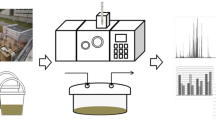Abstract
Purpose
The statistical evaluation of the chemical profile of seized hashish samples is a valuable tool to aid the estimation of the route through which the material has reached the dealers’ market.
Methods
In this study, the complete volatile organic compound (VOC) emission profiles of 48 seized hashish samples have been analyzed by means of headspace solid-phase microextraction/gas chromatography–mass spectrometry and evaluated with chemometric tools; multivariate statistical analyses, both hierarchical cluster analysis and principal component analysis (PCA) methods have been performed on the results to assess the existence of possible patterns throughout the samples.
Results
The total VOC emission profiles sharply distributed the samples in clusters based on their batches of origin; this trend was also clearly shown in the PCA plot, in which samples coming from the same seizure were grouped together. The Δ9-tetrahydrocannabinol (THC) content analysis did not show a relevant trend in terms of lot of origin of the samples.
Conclusions
The evaluation of the VOCs released into the headspace traced a much more complete chemical profiling of the samples, as compared to the analysis of cannabinoids only, or the THC titration. The multivariate statistical analyses were very useful to estimate the origin of the seized material.



Similar content being viewed by others
References
World Health Organization (2016) The health and social effects of nonmedical Cannabis use. WHO Document Production Services, Geneva (NLM classification: VM 296)
United Nations (1972) Single Convention on Narcotic Drugs, 1961, As amended by the 1972 Protocol amending the Single Convention on Narcotic Drugs, 1961. United Nations, New York, pp 1–44
Arnoldi S, Roda G, Casagni E, Dell’Acqua L, Cas MD, Fare F, Rusconi C, Visconti GL, Gambaro V (2017) Characterization of the volatile components of cannabis preparations by solid-phase microextraction coupled to headspace-gas chromatography with mass detector (SPME-HSGC/MS). J Chromatogr Sep Tech 8:350. https://doi.org/10.4172/2157-7064.1000350
Ferioli V, Rustichelli C, Pavesi G, Gamberini G (2000) Analytical characterization of hashish samples. Chromatographia 52:39–44. https://doi.org/10.1007/bf02490790
UNODC (2017) Market analysis of plant-based drugs: opiates, cocaine, cannabis, World Drug Report 2017. United Nations Office on Drugs and Crime, Vienna
Baker PB, Fowler R, Bagon KR, Gough TA (1980) Determination of the distribution of cannabinoids in cannabis resin using high performance liquid chromatography. J Anal Toxicol 4:145–152. https://doi.org/10.1093/jat/4.3.145
Baker PB, Gough TA, Wagstaffe PJ (1983) Determination of the distribution of cannabinoids in cannabis resin from Morocco using high-performance liquid chromatography. Part II. J Anal Toxicol 7:7–10. https://doi.org/10.1093/jat/7.1.7
Osman A, Thorpe JW, Caddy B (1985) Comparison of cannabis samples from different origins by the headspace technique and an assessment of chromatographic traces using the r-matrix. J Forensic Sci Soc 25:427–433. https://doi.org/10.1016/S0015-7368(85)72431-0
Marchini M, Charvoz C, Dujourdy L, Baldovini N, Filippi J-J (2014) Multidimensional analysis of cannabis volatile constituents: identification of 5,5-dimethyl-1-vinylbicyclo[2.1.1]hexane as a volatile marker of hashish, the resin of Cannabis sativa L. J Chromatogr A 1370:200–215. https://doi.org/10.1016/j.chroma.2014.10.045
UNODC (2009) Guidelines on representative drug sampling. United Nations Office on Drugs and Crime, Vienna
Stenhagen E, Abrahamsson S, McLafferty FW (1974) Registry of mass spectral data. Wiley, New York
Masada Y (1976) Analysis of essential oils by gas chromatography and mass spectrometry. Wiley, New York
Jennings W, Shibamoto T (1982) Qualitative analysis of flavor and fragrance volatiles by glass capillary gas chromatography. Academic Press, New York
Davies NW (1990) Gas chromatographic retention indices of monoterpenes and sesquiterpenes on methyl silicon and Carbowax 20 M phases. J Chromatogr A 503:1–24. https://doi.org/10.1016/S0021-9673(01)81487-4
Adams RP (1995) Identification of essential oil components by gas chromatography/quadrupole mass spectroscopy. Allured Publishing Corporation, Carol Stream
Choi YH, Kim HK, Hazekamp A, Erkelens C, Lefeber AWM, Verpoorte R (2004) Metabolomic differentiation of Cannabis sativa cultivars using 1H NMR spectroscopy and principal component analysis. J Nat Prod 67:953–957. https://doi.org/10.1021/np049919c
Higashikawa FS, Cayuela ML, Roig A, Silva CA, Sánchez-Monedero MA (2013) Matrix effect on the performance of headspace solid phase microextraction method for the analysis of target volatile organic compounds (VOCs) in environmental samples. Chemosphere 93:2311–2318. https://doi.org/10.1016/j.chemosphere.2013.08.023
Author information
Authors and Affiliations
Corresponding author
Ethics declarations
Conflict of interest
The authors have no conflicts of interest to declare.
Ethical approval
This article does not contain any studies with human participants or animals performed by any of the authors.
Rights and permissions
About this article
Cite this article
Ascrizzi, R., Flamini, G., Giusiani, M. et al. VOCs as fingerprints for the chemical profiling of hashish samples analyzed by HS-SPME/GC–MS and multivariate statistical tools. Forensic Toxicol 36, 243–260 (2018). https://doi.org/10.1007/s11419-017-0398-1
Received:
Accepted:
Published:
Issue Date:
DOI: https://doi.org/10.1007/s11419-017-0398-1




